Business Law - Trademark Dispute: Analysis of Mattel vs. Canada Inc.
VerifiedAdded on 2023/06/09
|5
|1108
|98
Case Study
AI Summary
This case study examines the trademark dispute between Mattel Inc. and Canada Inc., focusing on Canada Inc.'s attempt to use "Barbie's" as a trademark for its restaurant business. Mattel, concerned about potential confusion with its Barbie doll brand, opposed the registration. The case explores the arguments presented by both parties, the rulings of the Federal Court and Federal Court of Appeal, and the relevant legislation, specifically Section 6(2) of the Trademarks Act. The analysis delves into the issue of consumer confusion, the perspective for judging mistaken inferences, and the role of trademark surveys in protecting business owners. The courts ultimately sided with the trademark board, requesting fresh evidence from Mattel to prove consumer confusion. This assignment provides a comprehensive overview of the legal considerations and challenges in trademark disputes.
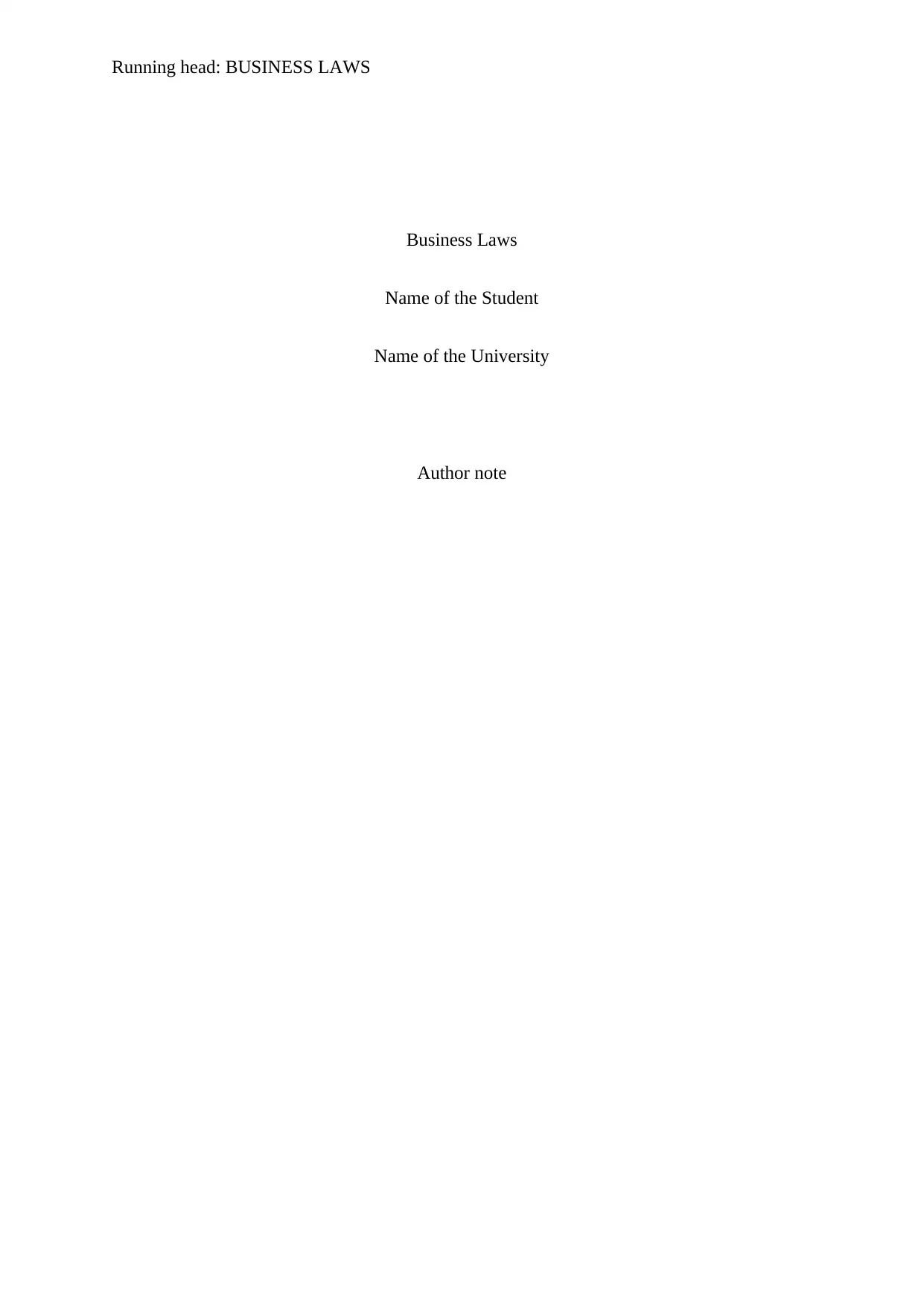
Running head: BUSINESS LAWS
Business Laws
Name of the Student
Name of the University
Author note
Business Laws
Name of the Student
Name of the University
Author note
Paraphrase This Document
Need a fresh take? Get an instant paraphrase of this document with our AI Paraphraser
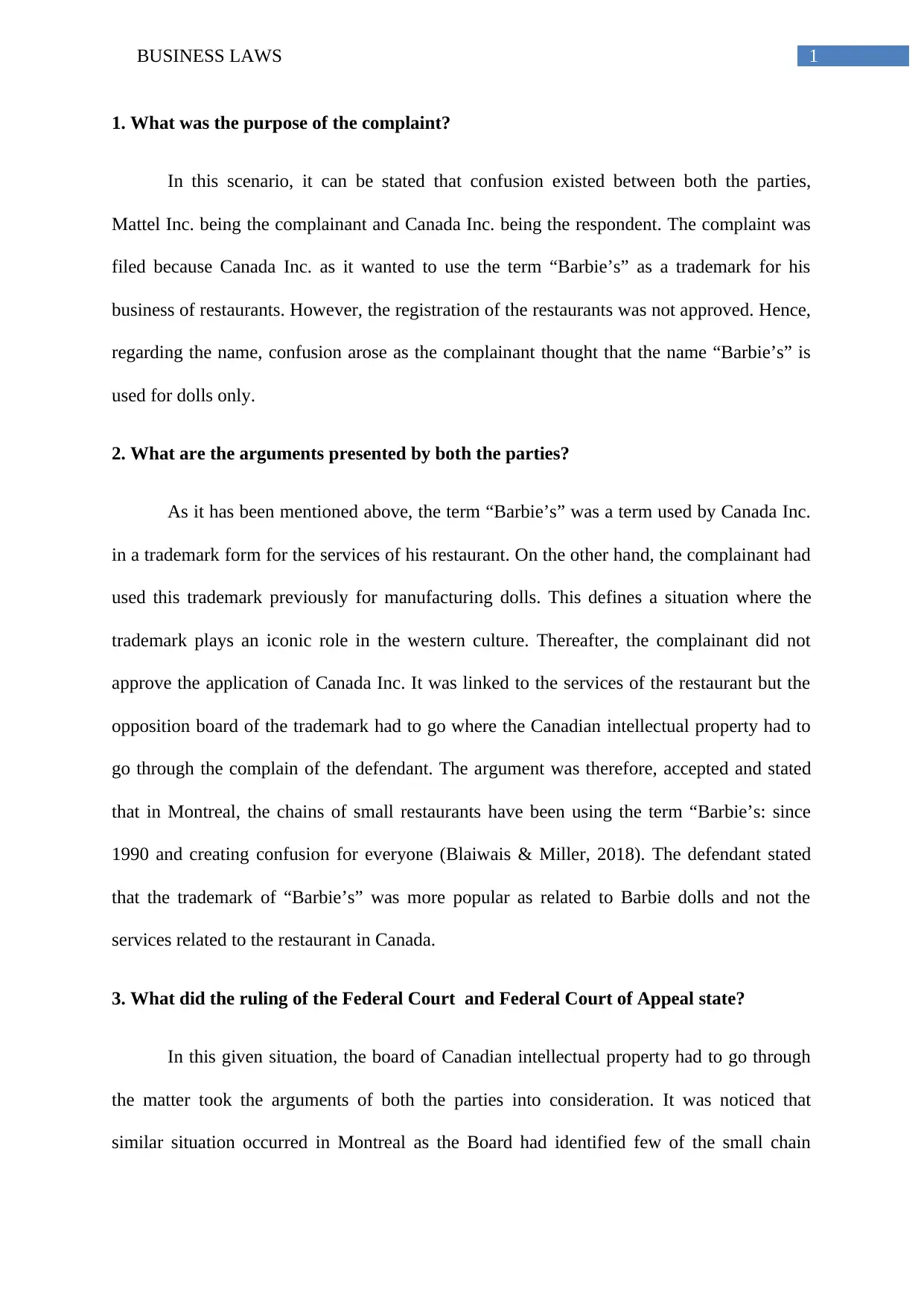
1BUSINESS LAWS
1. What was the purpose of the complaint?
In this scenario, it can be stated that confusion existed between both the parties,
Mattel Inc. being the complainant and Canada Inc. being the respondent. The complaint was
filed because Canada Inc. as it wanted to use the term “Barbie’s” as a trademark for his
business of restaurants. However, the registration of the restaurants was not approved. Hence,
regarding the name, confusion arose as the complainant thought that the name “Barbie’s” is
used for dolls only.
2. What are the arguments presented by both the parties?
As it has been mentioned above, the term “Barbie’s” was a term used by Canada Inc.
in a trademark form for the services of his restaurant. On the other hand, the complainant had
used this trademark previously for manufacturing dolls. This defines a situation where the
trademark plays an iconic role in the western culture. Thereafter, the complainant did not
approve the application of Canada Inc. It was linked to the services of the restaurant but the
opposition board of the trademark had to go where the Canadian intellectual property had to
go through the complain of the defendant. The argument was therefore, accepted and stated
that in Montreal, the chains of small restaurants have been using the term “Barbie’s: since
1990 and creating confusion for everyone (Blaiwais & Miller, 2018). The defendant stated
that the trademark of “Barbie’s” was more popular as related to Barbie dolls and not the
services related to the restaurant in Canada.
3. What did the ruling of the Federal Court and Federal Court of Appeal state?
In this given situation, the board of Canadian intellectual property had to go through
the matter took the arguments of both the parties into consideration. It was noticed that
similar situation occurred in Montreal as the Board had identified few of the small chain
1. What was the purpose of the complaint?
In this scenario, it can be stated that confusion existed between both the parties,
Mattel Inc. being the complainant and Canada Inc. being the respondent. The complaint was
filed because Canada Inc. as it wanted to use the term “Barbie’s” as a trademark for his
business of restaurants. However, the registration of the restaurants was not approved. Hence,
regarding the name, confusion arose as the complainant thought that the name “Barbie’s” is
used for dolls only.
2. What are the arguments presented by both the parties?
As it has been mentioned above, the term “Barbie’s” was a term used by Canada Inc.
in a trademark form for the services of his restaurant. On the other hand, the complainant had
used this trademark previously for manufacturing dolls. This defines a situation where the
trademark plays an iconic role in the western culture. Thereafter, the complainant did not
approve the application of Canada Inc. It was linked to the services of the restaurant but the
opposition board of the trademark had to go where the Canadian intellectual property had to
go through the complain of the defendant. The argument was therefore, accepted and stated
that in Montreal, the chains of small restaurants have been using the term “Barbie’s: since
1990 and creating confusion for everyone (Blaiwais & Miller, 2018). The defendant stated
that the trademark of “Barbie’s” was more popular as related to Barbie dolls and not the
services related to the restaurant in Canada.
3. What did the ruling of the Federal Court and Federal Court of Appeal state?
In this given situation, the board of Canadian intellectual property had to go through
the matter took the arguments of both the parties into consideration. It was noticed that
similar situation occurred in Montreal as the Board had identified few of the small chain
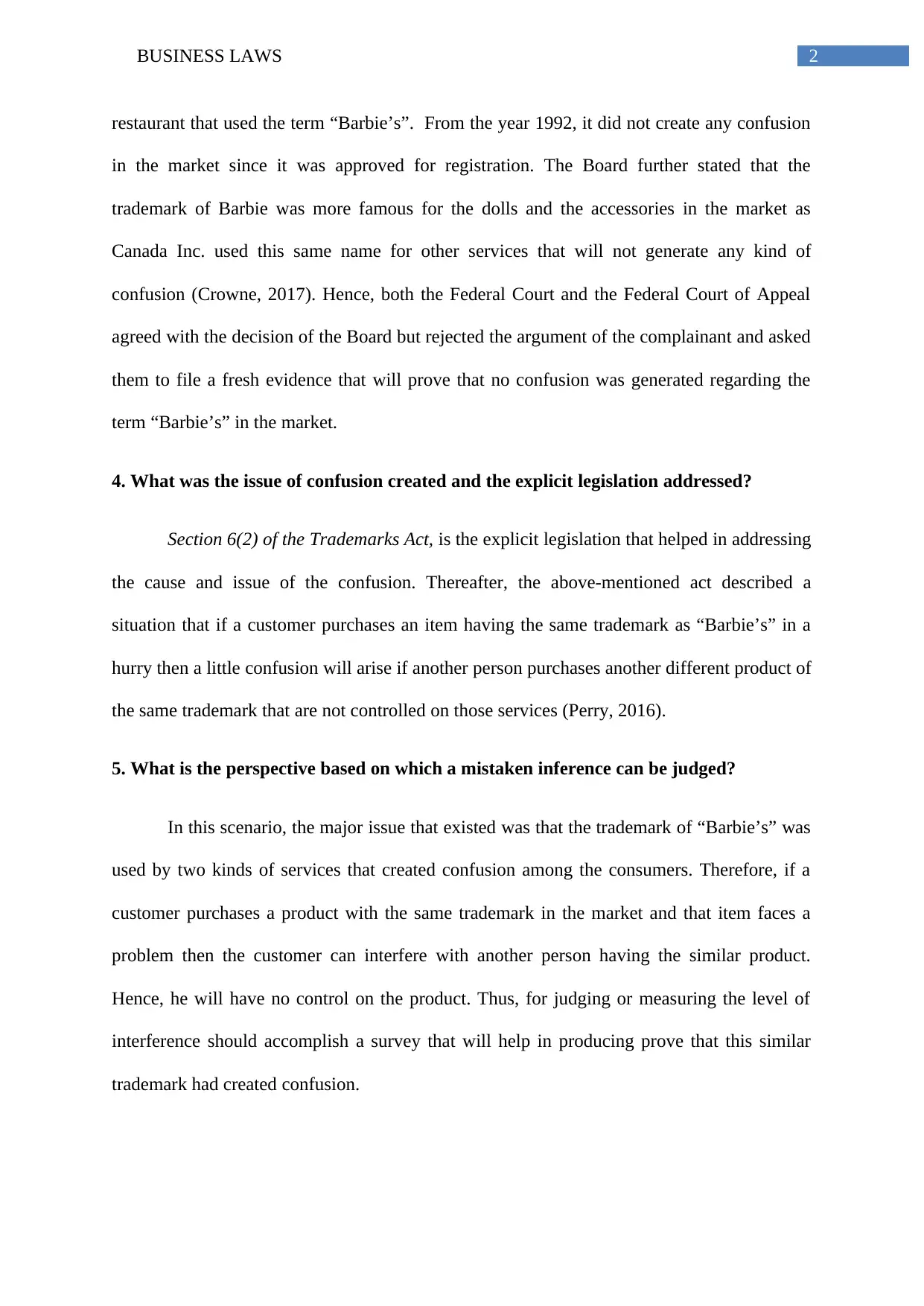
2BUSINESS LAWS
restaurant that used the term “Barbie’s”. From the year 1992, it did not create any confusion
in the market since it was approved for registration. The Board further stated that the
trademark of Barbie was more famous for the dolls and the accessories in the market as
Canada Inc. used this same name for other services that will not generate any kind of
confusion (Crowne, 2017). Hence, both the Federal Court and the Federal Court of Appeal
agreed with the decision of the Board but rejected the argument of the complainant and asked
them to file a fresh evidence that will prove that no confusion was generated regarding the
term “Barbie’s” in the market.
4. What was the issue of confusion created and the explicit legislation addressed?
Section 6(2) of the Trademarks Act, is the explicit legislation that helped in addressing
the cause and issue of the confusion. Thereafter, the above-mentioned act described a
situation that if a customer purchases an item having the same trademark as “Barbie’s” in a
hurry then a little confusion will arise if another person purchases another different product of
the same trademark that are not controlled on those services (Perry, 2016).
5. What is the perspective based on which a mistaken inference can be judged?
In this scenario, the major issue that existed was that the trademark of “Barbie’s” was
used by two kinds of services that created confusion among the consumers. Therefore, if a
customer purchases a product with the same trademark in the market and that item faces a
problem then the customer can interfere with another person having the similar product.
Hence, he will have no control on the product. Thus, for judging or measuring the level of
interference should accomplish a survey that will help in producing prove that this similar
trademark had created confusion.
restaurant that used the term “Barbie’s”. From the year 1992, it did not create any confusion
in the market since it was approved for registration. The Board further stated that the
trademark of Barbie was more famous for the dolls and the accessories in the market as
Canada Inc. used this same name for other services that will not generate any kind of
confusion (Crowne, 2017). Hence, both the Federal Court and the Federal Court of Appeal
agreed with the decision of the Board but rejected the argument of the complainant and asked
them to file a fresh evidence that will prove that no confusion was generated regarding the
term “Barbie’s” in the market.
4. What was the issue of confusion created and the explicit legislation addressed?
Section 6(2) of the Trademarks Act, is the explicit legislation that helped in addressing
the cause and issue of the confusion. Thereafter, the above-mentioned act described a
situation that if a customer purchases an item having the same trademark as “Barbie’s” in a
hurry then a little confusion will arise if another person purchases another different product of
the same trademark that are not controlled on those services (Perry, 2016).
5. What is the perspective based on which a mistaken inference can be judged?
In this scenario, the major issue that existed was that the trademark of “Barbie’s” was
used by two kinds of services that created confusion among the consumers. Therefore, if a
customer purchases a product with the same trademark in the market and that item faces a
problem then the customer can interfere with another person having the similar product.
Hence, he will have no control on the product. Thus, for judging or measuring the level of
interference should accomplish a survey that will help in producing prove that this similar
trademark had created confusion.
⊘ This is a preview!⊘
Do you want full access?
Subscribe today to unlock all pages.

Trusted by 1+ million students worldwide
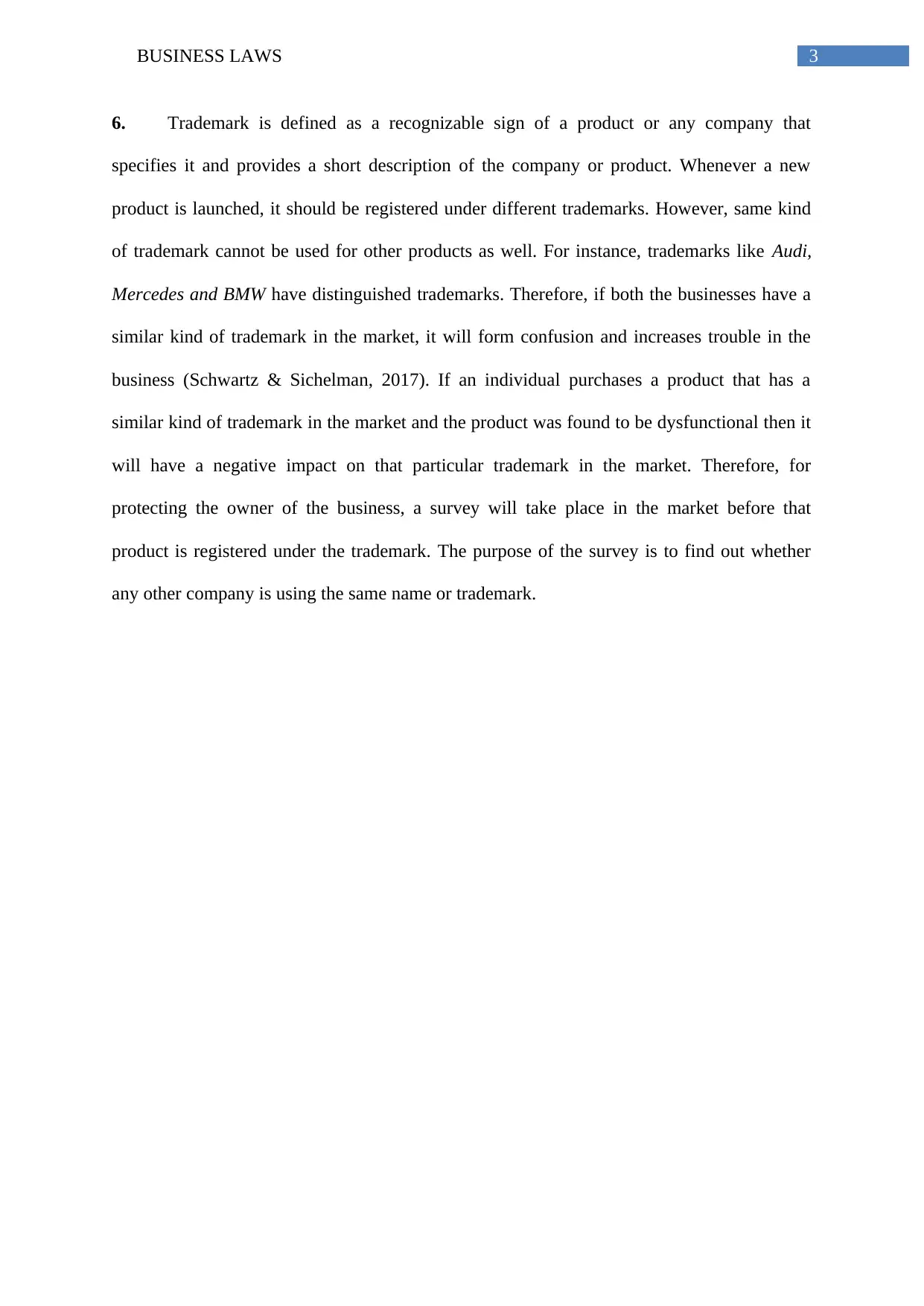
3BUSINESS LAWS
6. Trademark is defined as a recognizable sign of a product or any company that
specifies it and provides a short description of the company or product. Whenever a new
product is launched, it should be registered under different trademarks. However, same kind
of trademark cannot be used for other products as well. For instance, trademarks like Audi,
Mercedes and BMW have distinguished trademarks. Therefore, if both the businesses have a
similar kind of trademark in the market, it will form confusion and increases trouble in the
business (Schwartz & Sichelman, 2017). If an individual purchases a product that has a
similar kind of trademark in the market and the product was found to be dysfunctional then it
will have a negative impact on that particular trademark in the market. Therefore, for
protecting the owner of the business, a survey will take place in the market before that
product is registered under the trademark. The purpose of the survey is to find out whether
any other company is using the same name or trademark.
6. Trademark is defined as a recognizable sign of a product or any company that
specifies it and provides a short description of the company or product. Whenever a new
product is launched, it should be registered under different trademarks. However, same kind
of trademark cannot be used for other products as well. For instance, trademarks like Audi,
Mercedes and BMW have distinguished trademarks. Therefore, if both the businesses have a
similar kind of trademark in the market, it will form confusion and increases trouble in the
business (Schwartz & Sichelman, 2017). If an individual purchases a product that has a
similar kind of trademark in the market and the product was found to be dysfunctional then it
will have a negative impact on that particular trademark in the market. Therefore, for
protecting the owner of the business, a survey will take place in the market before that
product is registered under the trademark. The purpose of the survey is to find out whether
any other company is using the same name or trademark.
Paraphrase This Document
Need a fresh take? Get an instant paraphrase of this document with our AI Paraphraser
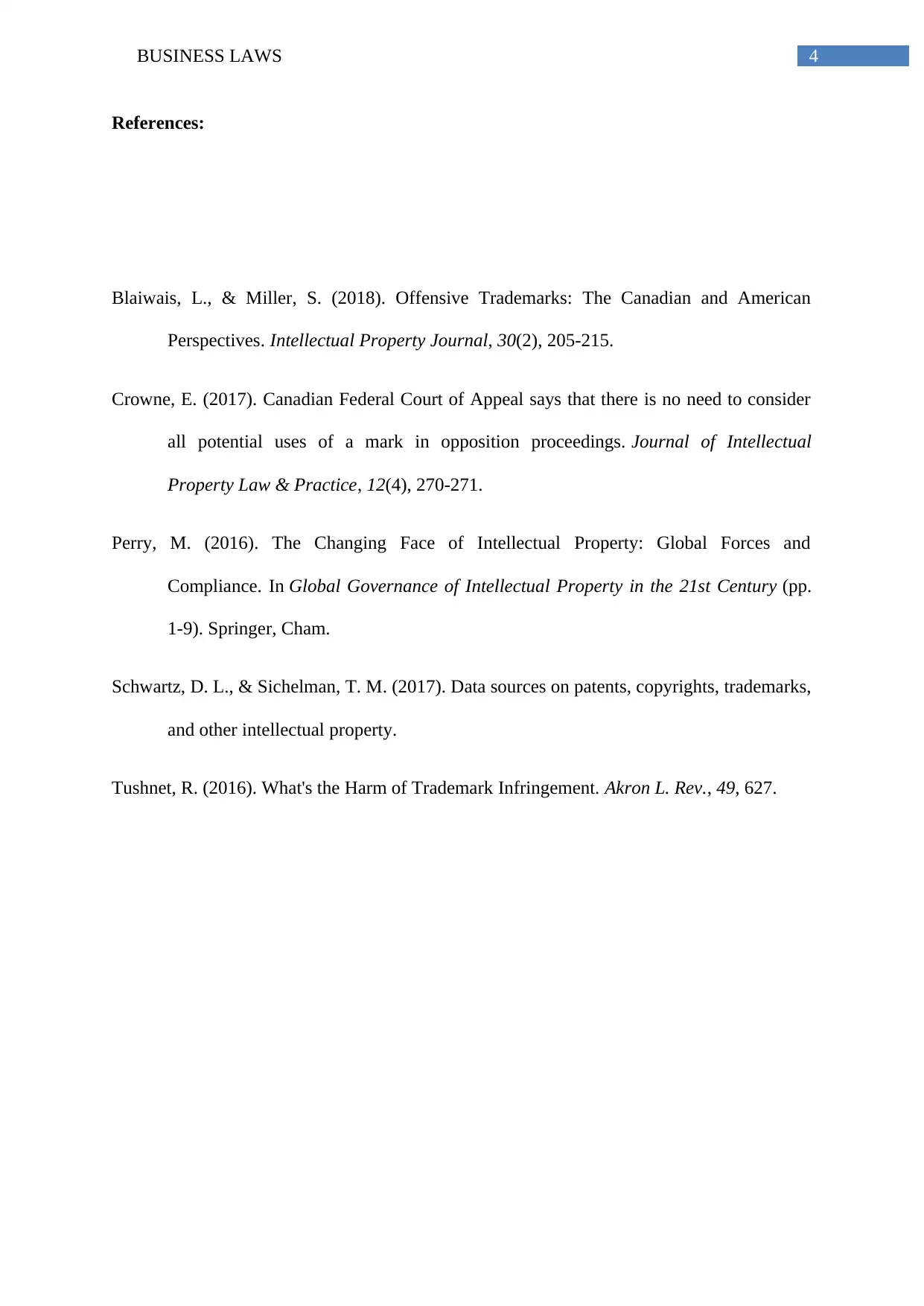
4BUSINESS LAWS
References:
Blaiwais, L., & Miller, S. (2018). Offensive Trademarks: The Canadian and American
Perspectives. Intellectual Property Journal, 30(2), 205-215.
Crowne, E. (2017). Canadian Federal Court of Appeal says that there is no need to consider
all potential uses of a mark in opposition proceedings. Journal of Intellectual
Property Law & Practice, 12(4), 270-271.
Perry, M. (2016). The Changing Face of Intellectual Property: Global Forces and
Compliance. In Global Governance of Intellectual Property in the 21st Century (pp.
1-9). Springer, Cham.
Schwartz, D. L., & Sichelman, T. M. (2017). Data sources on patents, copyrights, trademarks,
and other intellectual property.
Tushnet, R. (2016). What's the Harm of Trademark Infringement. Akron L. Rev., 49, 627.
References:
Blaiwais, L., & Miller, S. (2018). Offensive Trademarks: The Canadian and American
Perspectives. Intellectual Property Journal, 30(2), 205-215.
Crowne, E. (2017). Canadian Federal Court of Appeal says that there is no need to consider
all potential uses of a mark in opposition proceedings. Journal of Intellectual
Property Law & Practice, 12(4), 270-271.
Perry, M. (2016). The Changing Face of Intellectual Property: Global Forces and
Compliance. In Global Governance of Intellectual Property in the 21st Century (pp.
1-9). Springer, Cham.
Schwartz, D. L., & Sichelman, T. M. (2017). Data sources on patents, copyrights, trademarks,
and other intellectual property.
Tushnet, R. (2016). What's the Harm of Trademark Infringement. Akron L. Rev., 49, 627.
1 out of 5
Your All-in-One AI-Powered Toolkit for Academic Success.
+13062052269
info@desklib.com
Available 24*7 on WhatsApp / Email
![[object Object]](/_next/static/media/star-bottom.7253800d.svg)
Unlock your academic potential
Copyright © 2020–2025 A2Z Services. All Rights Reserved. Developed and managed by ZUCOL.

